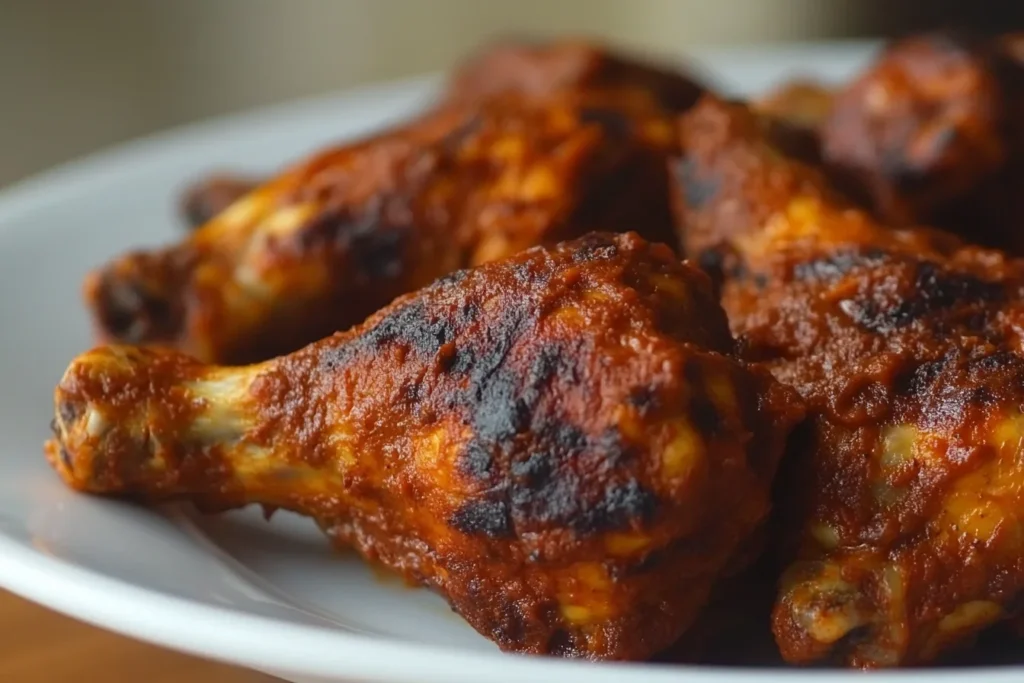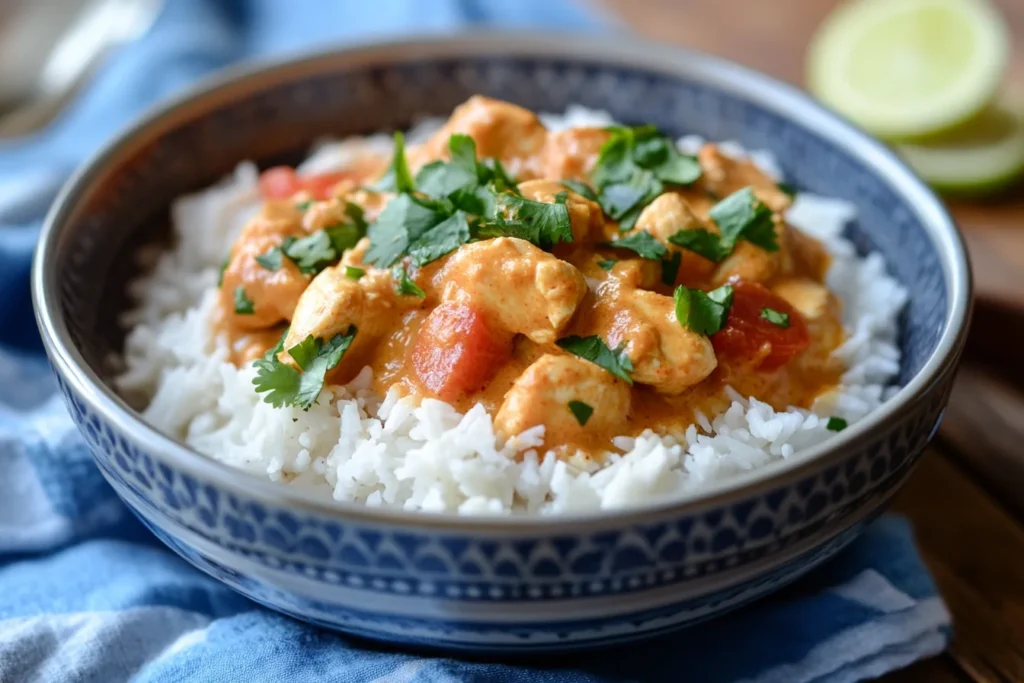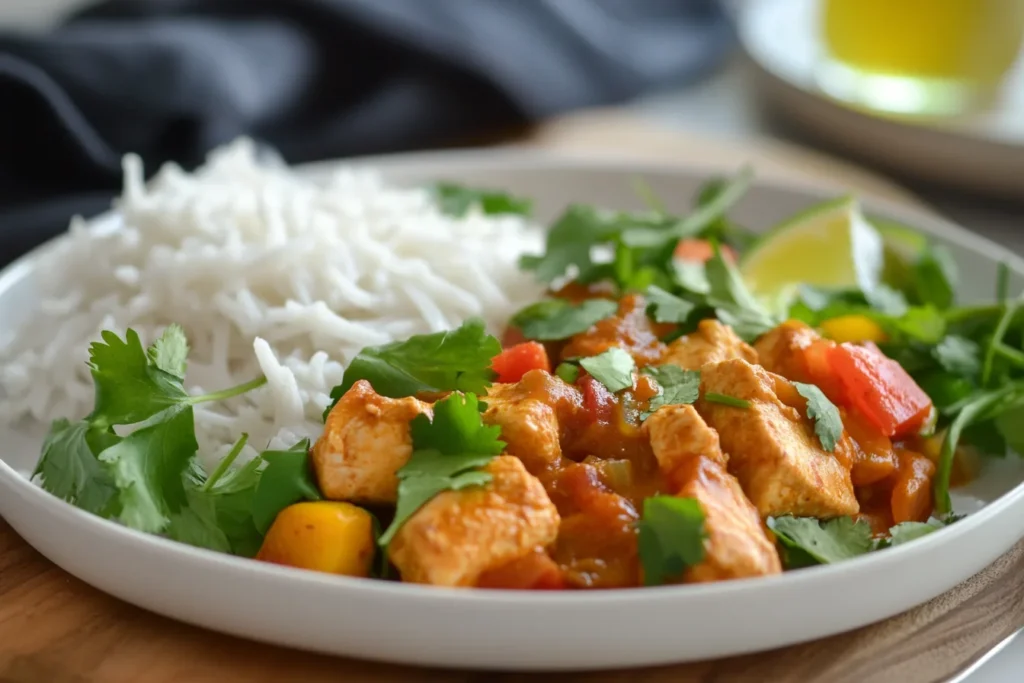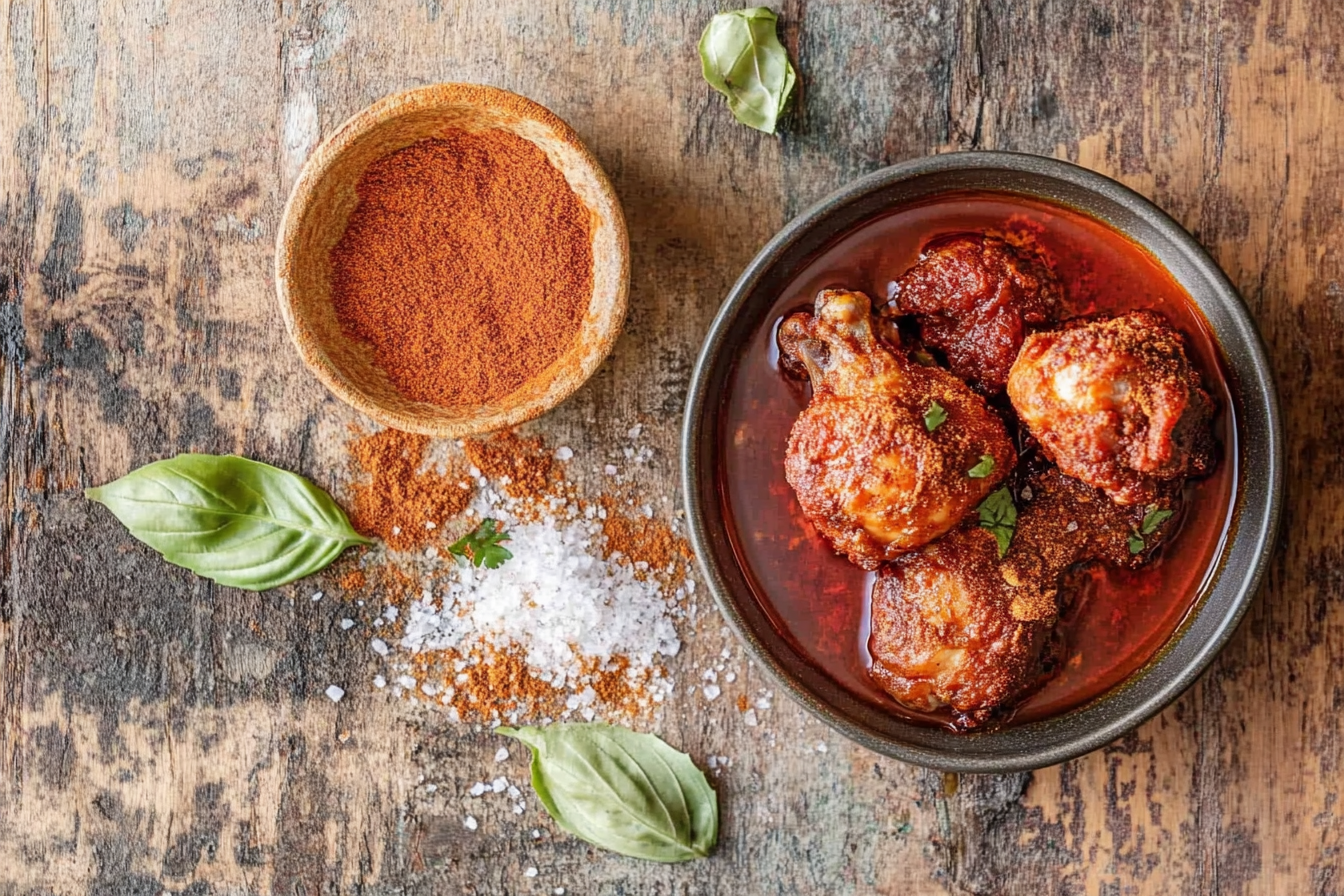Why Homemade Chicken Masala Powder is Superior
Nothing compares to the aroma and freshness of homemade Chicken Masala Powder. Unlike store-bought masala, making your own gives you full control over the ingredients, allowing for customization to suit your taste. It ensures you’re working with the freshest spices, devoid of any preservatives or additives.
This guide will walk you through everything you need to know, from choosing the right spices to perfectly storing your homemade masala powder.
What is Chicken Masala Powder?
Chicken Masala Powder is a flavorful spice blend integral to Indian cuisine. This versatile mix is the backbone of popular dishes like Chicken Curry, Butter Chicken, and Tandoori. The combination of aromatic spices like coriander, cumin, and cardamom adds depth and complexity to chicken recipes, elevating their taste to an entirely new level.
Chicken Masala Powder isn’t limited to curries. It’s also an excellent seasoning for marinades, grills, and stews, ensuring you get a consistent flavor profile across dishes.
Benefits of Making Chicken Masala Powder at Home
There are several advantages to preparing your Chicken Masala Powder at home:
- Cost-Effectiveness: Homemade masala is often cheaper as you can buy whole spices in bulk and grind them yourself.
- Freshness: The flavor and aroma of freshly ground spices are unparalleled.
- Customization: You can tweak the spice blend to suit regional preferences or dietary restrictions.
Whether you like your masala spicy, mild, or aromatic, making it at home allows for endless variations.

Key Ingredients for Chicken Masala Powder
A robust Chicken Masala Powder relies on the careful selection of whole spices. Here’s an overview of the core ingredients:
Common Spices
- Cumin Seeds: Adds an earthy base.
- Coriander Seeds: Contributes citrusy undertones.
- Cloves: Impart a warm and sweet-spicy flavor.
- Black Peppercorns: For a sharp, spicy kick.
- Green and Black Cardamom: Elevate the aroma.
- Cinnamon Sticks: Provide a sweet-spicy warmth.
- Dried Red Chilies: Bring heat and vibrancy.
- Turmeric Powder: Adds color and earthy flavor.
Choosing the Right Spices
Always opt for whole, fresh spices rather than pre-ground ones. Whole spices retain their essential oils, ensuring maximum flavor. Look for brightly colored, fragrant, and unblemished spices for the best results.
Tools Required to Make Chicken Masala Powder
Making your Chicken Masala Powder requires a few basic tools to ensure a smooth process:
- Grinder: A high-quality electric grinder is ideal for fine consistency, but a manual grinder works as well.
- Roasting Pan: Used for dry-roasting spices to enhance their natural flavors.
- Measuring Tools: Ensure accurate spice proportions.
Preparing Your Kitchen
Before starting, make sure your equipment is clean and completely dry. Moisture can spoil the spices and reduce the shelf life of your masala.
Storing Chicken Masala Powder
Proper storage is essential for retaining the flavor and potency of your Chicken Masala Powder.
Optimal Storage Containers
- Use glass jars with airtight lids for optimal freshness.
- Avoid plastic containers, as they may absorb odors and leach chemicals.
- Store in a cool, dry place away from direct sunlight.
Pro Tip: Label and date your jar to track the masala’s freshness. Homemade masala powder typically lasts 3-6 months when stored correctly.
Part 2: Step-by-Step Guide to Making Chicken Masala Powder

Step 1: Gathering Ingredients
The first step to preparing perfect Chicken Masala Powder is assembling the right ingredients in precise quantities. Here’s a common ratio for a balanced flavor profile:
Ingredients
- Coriander Seeds: 4 tablespoons
- Cumin Seeds: 2 tablespoons
- Cloves: 8-10 pieces
- Black Peppercorns: 1 tablespoon
- Green Cardamom: 6 pods
- Black Cardamom: 2 pods
- Cinnamon Stick: 2-inch piece
- Dried Red Chilies: 5-7 (adjust based on heat preference)
- Turmeric Powder: 1 teaspoon
- Nutmeg (optional): A small piece for added depth
Pro Tip:
Use fresh, whole spices to ensure the most aromatic and flavorful masala powder. If possible, purchase spices from trusted local stores or spice markets.
Step 2: Cleaning the Spices
Before roasting, it’s essential to clean your spices to remove any dust, dirt, or impurities.
- Spread the spices on a clean, dry plate.
- Inspect for small stones or debris, especially in seeds like cumin and coriander.
- Lightly wipe any larger pieces (e.g., cinnamon sticks or cardamom) with a clean, dry cloth.
Avoid washing spices as moisture can cause them to stick together during roasting.
Step 3: Roasting the Spices
Dry roasting the spices is a key step that enhances their natural oils, resulting in a richer flavor.
How to Dry Roast:
- Heat a heavy-bottomed pan on low-medium heat.
- Add the spices in small batches to prevent overcrowding.
- Roast each spice until it releases a distinct aroma and changes color slightly (e.g., cumin seeds will darken).
- Stir continuously to prevent burning.
Best Practices for Roasting:
- Maintain a low heat setting to avoid overcooking.
- Roast lighter spices (e.g., coriander seeds) separately from heavier ones (e.g., cinnamon sticks).
- Cool roasted spices completely before grinding to preserve their flavor.
Step 4: Grinding the Spices
Once your spices are roasted and cooled, it’s time to grind them into a fine powder.
Types of Grinders:
- Electric Grinder: Produces a fine and consistent texture.
- Manual Grinder: Allows more control over texture but requires effort.
Steps:
- Transfer the roasted spices to the grinder in batches.
- Grind for 30-60 seconds, checking the consistency.
- For a finer texture, sift the ground spices through a fine mesh sieve and re-grind the coarser particles.
Step 5: Cooling the Masala
After grinding, let the masala cool completely before transferring it to storage containers. This step is crucial for preventing condensation, which could lead to clumping or spoilage.
- Spread the freshly ground powder on a large, dry plate or tray.
- Allow it to rest for 15-20 minutes at room temperature.
Step 6: Storing the Finished Powder
Proper storage ensures that your Chicken Masala Powder retains its aroma and flavor for months.
Steps:
- Use airtight, light-blocking jars for storage.
- Keep the jar in a cool, dry place like a pantry.
- Label the jar with the date of preparation.
Labeling and Dating:
- Homemade masala is best used within 3-6 months.
- A label helps you track its freshness and avoid accidental use of expired masala.
Adjustments for Regional Tastes
Chicken Masala Powder varies significantly across Indian regions. Here’s how you can tweak the ingredients for a more localized flavor:
North Indian Style:
- Add more cloves, nutmeg, and mace for a richer, warmer profile.
- Use Kashmiri red chilies for a vibrant red color without excessive heat.
South Indian Style:
- Incorporate fennel seeds, curry leaves, and dried coconut for a distinctive flavor.
- Use spicier red chilies for added heat.
Example Recipe Using Chicken Masala Powder:
A simple chicken curry becomes extraordinary with just 2-3 teaspoons of this freshly ground spice mix. Combine it with onions, tomatoes, and ginger-garlic paste for a restaurant-quality dish at home.

Part 3: Uses, Variations, and Tips for Chicken Masala Powder
How to Use Chicken Masala Powder in Recipes
Chicken Masala Powder is the ultimate flavor enhancer for a variety of dishes. Its versatility allows it to shine in curries, grilled dishes, and even soups. Here’s how you can incorporate it:
Common Uses:
- Chicken Curries: Add 2-3 teaspoons of Chicken Masala Powder during cooking for a rich, aromatic base.
- Marinades: Mix the powder with yogurt, lemon juice, and salt to create a flavorful marinade for chicken tikka or grilled chicken.
- Soups and Stews: Sprinkle a pinch to elevate soups or chicken stews with a subtle spicy kick.
- Rice Dishes: Use it to add depth to biryanis or spiced pilafs.
Pro Tip: Add the masala towards the middle or end of cooking to retain its full flavor.
Adjusting Spice Levels
Not all dishes call for the same level of heat or intensity. You can tweak the Chicken Masala Powder to suit your palate:
- For Milder Flavor: Reduce the number of dried red chilies and black peppercorns.
- For Spicier Dishes: Increase chilies and cloves for a fiery kick.
Remember, balance is key. Overloading on any one spice can overpower the rest of the flavors.
Variations of Chicken Masala Powder
Regional Adaptations:
- North Indian Variation: Known for its rich, robust flavors, this version includes mace, nutmeg, and an extra dose of cloves.
- South Indian Variation: Incorporates fennel seeds, star anise, and curry leaves, which provide a distinct aroma and taste.
- International Twist: Add a hint of smoked paprika or allspice for a unique global flavor profile.
Adding Unique Ingredients:
For a signature twist, experiment with these ingredients:
- Nutmeg: For warm, sweet undertones.
- Star Anise: Adds a subtle licorice flavor.
- Dry Mango Powder (Amchur): Gives a tangy edge, especially for marinades.
Tips for Maintaining Aroma and Flavor
To ensure your homemade Chicken Masala Powder retains its freshness and potency:
- Store Properly: Use airtight glass jars and keep them in a cool, dark place.
- Avoid Moisture: Always use a dry spoon to prevent clumping.
- Small Batches: Make small quantities to use up within 3-6 months.
Pro Tip: Toast the powder lightly before using in recipes for an extra punch of aroma.
Mistakes to Avoid While Making Chicken Masala Powder
Avoid these common errors for the best results:
- Over-Roasting Spices: Can lead to a bitter taste. Stick to low heat and remove spices as soon as they release an aroma.
- Skipping Cooling: Packing warm powder into jars can cause condensation and spoilage.
- Using Old Spices: Always use fresh, high-quality spices for the most aromatic blend.
Benefits of Freshly Ground Spices
Freshly ground spices are packed with aroma, flavor, and nutritional value. When you make your Chicken Masala Powder at home:
- The essential oils in spices remain intact, enhancing taste.
- You can avoid preservatives and fillers commonly found in store-bought mixes.
- The blend stays free of artificial colors or additives.
Frequently Asked Questions About Chicken Masala Powder
1. Can I Skip Roasting the Spices?
Roasting is essential as it enhances the natural oils and aromas of the spices. Skipping it will result in a less flavorful masala.
2. How Long Can I Store Chicken Masala Powder?
Homemade masala lasts for 3-6 months if stored in an airtight container away from light and moisture.
3. Can I Use Pre-Ground Spices Instead of Whole Spices?
While convenient, pre-ground spices lack the aroma and flavor of freshly ground whole spices. Whole spices are always better.
4. What’s the Best Grinder for Spices?
An electric coffee grinder works well for a fine texture, while a manual grinder is ideal for small batches.
5. Can I Use Chicken Masala Powder for Vegetarian Dishes?
Yes! It’s versatile and works well in paneer, tofu, or vegetable curries.
6. Why Is My Masala Bitter?
Over-roasting the spices or using too many cloves can make the blend bitter. Stick to the recommended quantities and roasting times.
7. Can I Adjust the Ingredients for Regional Tastes?
Absolutely. Add or reduce spices like fennel seeds, nutmeg, or red chilies to match your preferred flavor profile.
8. What’s the Difference Between Chicken Masala and Garam Masala?
Chicken Masala is a specialized blend for chicken dishes, while Garam Masala is a generic mix used across various recipes.
9. How Do I Make the Masala Spicier?
Increase the number of dried red chilies and black peppercorns in the recipe.
10. Are There Reliable Store-Bought Alternatives?
If you’re short on time, brands like Everest, MDH, or Catch offer good-quality Chicken Masala Powder.
Conclusion
Making Chicken Masala Powder at home is a rewarding culinary experience. It guarantees freshness, customization, and unmatched flavor. Whether you’re preparing a hearty chicken curry or experimenting with new recipes, this spice mix will elevate your dishes. Take a step towards healthier and tastier meals by trying this recipe today!
This concludes Part 3. Let me know if you need further assistance or would like additional sections added!

